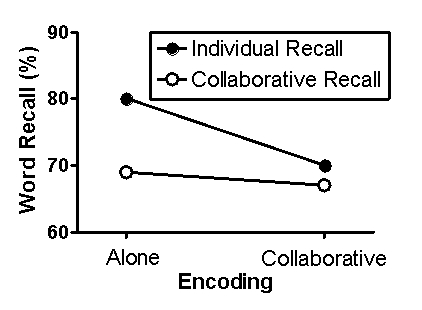Use the following to answer questions
Scenario I
Scenario I is based on and provides fabricated data consistent with the following study:
Barber,S.J. ,Rajaram,S. ,& Fox,E.B.(2012) .Learning and remembering with others: The key role of retrieval in shaping group recall and collective memory.Social Cognition,30(1) ,121-132.doi:10.1521/soco.2012.30.1.121
In a typical experiment on collaborative memory,participants first encode information individually and later attempt to recall the information either individually or in a small group (collaboratively) .While the recall of the collaborative group is better than that of any individual,the summed recall of individuals typically is better than the recall of the collaborative group.This is a phenomenon termed collaborative inhibition.Barber,Rajaram,and Fox (2012) investigated this phenomenon during both the encoding and retrieval stages of memory.
Participants created sentences out of a word bank,which provided for the opportunity to encode this information.After completing this task,participants engaged in an unrelated task-solving mazes-for 10 minutes.Then,in a surprise memory test,they were asked to recall as many words from the word bank as possible (retrieval) .
Participants were randomly assigned to one of four groups.In the first group (Alone-Alone) ,participants were studied individually during both the encoding and retrieval phases of the experiment.In the second group (Alone-Collaborative) ,participants were studied individually during the encoding phase and studied as part of a three-member team (triad) during the retrieval phase.In the third group (Collaborative-Alone) ,participants were studied in a triad during the encoding phase but individually during the retrieval phase.Finally,in the fourth group (Collaborative-Collaborative) ,participants completed both phases of the experiment as part of a triad.
Fabricated results illustrating the major finding of Barber et al.(2012) are presented in Figure 6.1.This figure shows the percentage of words from the word bank accurately recalled as a function of group.For the two groups that experienced the retrieval phase individually,scores represent the summed retrieval of the individuals comprising the group.For the two groups that experienced the retrieval phase as part of a triad,scores simply represent the collaborative performance.
Figure 6.1 
-(Scenario I) One possible explanation of collaborative inhibition is social loafing,or the established phenomenon that people do not exert as much effort on a task when studied as part of a group relative to when studied individually.A careful examination of the procedure and results,however,suggests that social loafing does not explain collaborative inhibition because:
Definitions:
Social Evolution
The gradual development and progression of societies and cultures over time through mechanisms such as adaptation, selection, and innovation.
Biological Evolution
The process through which species of organisms undergo changes over time through genetic variation and natural selection.
Physiological Response
A natural, automatic bodily reaction to stimuli, which can include changes in heart rate, hormone levels, or muscle tension.
Behavioral Response
A behavioral response is an observable action or set of actions taken by an individual in reaction to an external or internal stimulus.
Q36: Collaborative recall typically is better than the
Q67: Four participants sign up for an experiment
Q121: Descartes believed that the mind was part
Q207: _ is a sleep disorder associated with
Q246: Which psychological problem is NOT associated with
Q258: Remembering how to ride your bike is
Q303: The brain waves associated with the first
Q461: In eyeblink conditioning,a tone is sounded immediately
Q480: If you are in a good mood
Q483: Tess,a huge American football fan,couldn't remember the